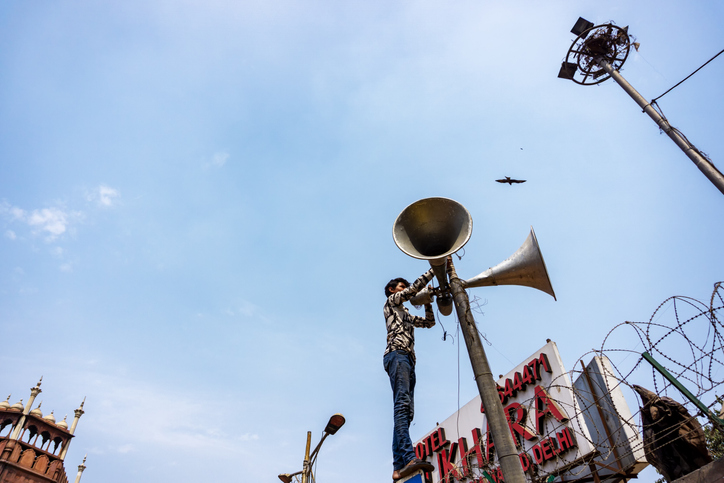
Loudspeaker over online classes: A teacher's innovation for students
A teacher in Jharkhand has put up several loudspeakers across the Bankathi village where his Upgraded Middle School is located, and classes are being held for two hours every day since April 16, beating the odds of online learning.

Teachers can change the world — a saying brought to life in Jharkhand when Shyam Kishore Singh Gandhi, the headmaster of a school in Dumka district, tried to educate his over 200 students, who may be bereft of smartphones but not the willingness to attend classes amid the lockdown.
Gandhi has put up several loudspeakers across the Bankathi village where his Upgraded Middle School is located, and classes are being held for two hours every day since April 16, beating the odds of online learning.
The students sit near the loudspeakers which have been put up on trees and walls at different locations, and attend the classes.
“Louder speakers are put up where the number of students is more. Five teachers and two para teachers teach over the mike from the classroom,” Gandhi said.
The noble initiative
Thousands of schools and colleges across India have switched to online as classrooms remain shut since mid-March amid the coronavirus outbreak.
“There are 246 students from class 1 to class 8, and 204 of them don’t have mobile phones,” Gandhi said, adding that the classes start at 10 am everyday.
“If the students have any doubt or want to ask any question, they can send their queries to me from anyone’s mobile phone and we explain it the next day,” he added.
Gandhi said the model is working and students are grasping well what is being taught.
Related news: More people turn to ed-tech firms as COVID-19 fear keeps people indoor
The students are receptive and are enjoying the new style of studying, said an elderly villager.
Lauding the headmaster, Dumka’s district education officer Poonam Kumari said all the 2,317 government schools in the district should emulate the model so that the students would not have to struggle to complete the syllabus once the lockdown is lifted.
The effort is praiseworthy and all the schools in Dumka district should follow this idea in the interest of the students, Kumari said, adding that she would soon visit the school and the village to learn about the teaching method.
Student suicides
Even as students in cities and towns across the country attend classes online, rural areas continue to grapple with the new system due to unsteady connectivity and lack of devices such as smartphones and computers.
There have been multiple incidents of suicides among students over not being able to attend online classes.
Related news: Dalit girl commits suicide for ‘being unable to join online classes’
A class 9 student set herself afire in Valancherry in Kerala earlier this month for not being able to attend online classes as she did not have a smartphone and the television in her house was not working.
Similar incidents have been reported from several other states, including Assam and West Bengal.
Digital divide
According to a survey conducted by online platform Local Circles, only 57 per cent students in the country have required hardware like computer, router and printer at home to attend online classes being conducted during the coronavirus lockdown.
The survey, with over 25,000 respondents, also pointed out problems being faced by students in sharing resources with parents who, as seen in many households, are also working from home.
“Around 57 per cent respondents said they have hardware like computer, tablet, printer and router, required for their children to participate in online classes from home while 43 per cent respondents said they do not have required resources,” the survey said.
“This means that two in every five parents do not have the necessary equipment to enable their wards to take the online classes which will start sometime in April. Some parents at schools where online classes already started last week expressed how they were letting their child use their computer for online classes and compromising on their work from home,” it reported.
Related news: Only 57% students have computers to attend online classes, finds survey
Another study ‘Scenario amidst COVID 19 – Onground Situations and Possible Solutions,’ conducted by the child rights NGO, Smile Foundation, with an aim of analysing the access to technology, revealed that about 56 percent of children were found to have no access to smartphones which have emerged as essential tools for online learning during the coronavirus-induced lockdown.
The study, in which 42,831 students at various school levels were surveyed, pointed out that 43.99 per cent of children have access to smartphones and another 43.99 per cent have access to basic phones while 12.02 per cent do not have access to either smartphones or basic phones.
A total of 56.01 per cent children were found to have no access to smartphones, the study said.
Santanu Mishra, co-founder and executive trustee, Smile Foundation, said the findings clearly show that the digital divide is a real challenge, and multiple approaches need to be implemented to cater to all across the nation.
“As an exercise before we start any programme, we do a baseline study to understand the on-ground challenges so that our programmes can bring in real work and real change. With the onset of the pandemic, following indefinite school closures, it is more important than ever to understand the situation and how can we ensure that children are given quality education. Through this, we understand that customized modules need to be built in accordance with the channel of communication,” he said.
Related news: About 56% of children have no access to smartphones for e-learning: Study
(With inputs from agencies)


